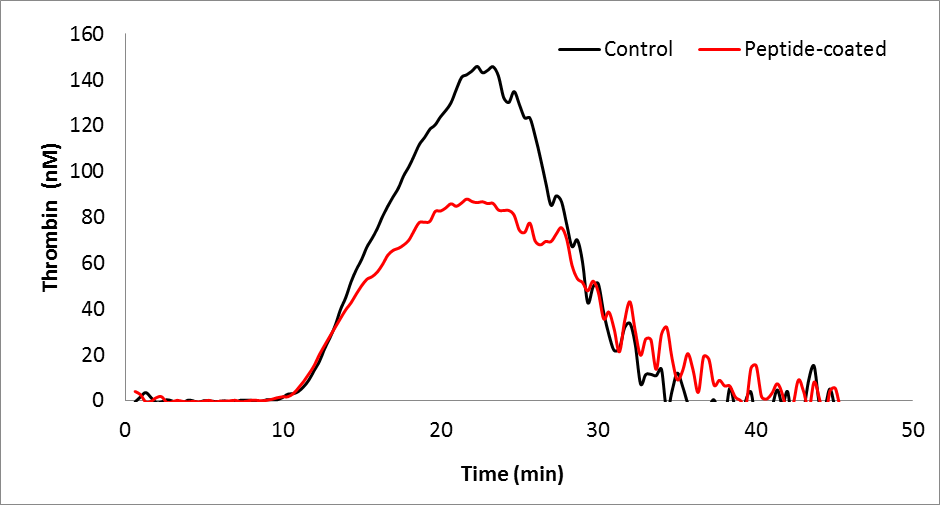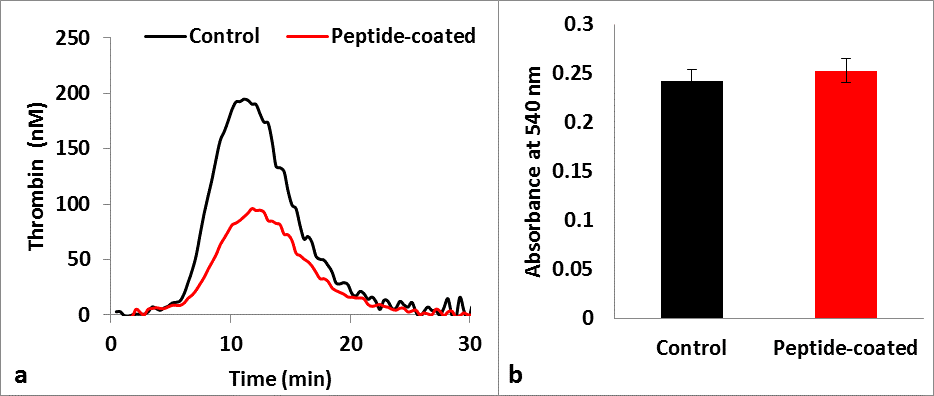Introduction: Thrombosis is a major concern in the design of most biomaterials, especially in those for vascular applications. Coating the biomaterial surface with a bioactive agent is one of the possible strategies to avoid thrombosis. CD31 (also known as PECAM-1) is a transmembrane glycoprotein present on endothelial cells, lymphocytes, neutrophils and platelets. CD31 has been demonstrated to inhibit platelet activation and thrombus formation[1],[2] and to modulate thrombin-induced tissue factor expression on endothelial cells[3].We therefore assessed the potential of a CD31-agonist peptide as an anti-thrombotic coating for biomaterials.
Materials and Methods: The CD31-agonist peptide was left to adsorb on a 96-well plate with high binding affinity (Immulon® 2 HB, Thermo Scientific). Excess peptide was rinsed with phosphate buffered saline (PBS). Unmodified wells of the same plate were used as control. In a first set of experiments, thrombin generation in platelet-rich plasma (PRP) was performed using a Calibrated Automated Thrombogram (CAT) in presence of 0.5 pM tissue factor (TF), in a Fluoroskan Ascent (Thermo Scientific). In a second set, human coronary artery endothelial cells (HCAEC) were cultured in a 96-well plate with or without peptide coating until confluence was reached. Then, thrombin generation was measured at the surface of the cells in platelet-poor plasma (PPP) and in presence of 1 pM TF. To estimate cell viability, a tetrazolium (MTT, Sigma Aldrich) colorimetric assay was performed in parallel.

Figure 1. Typical curve of thrombin generation in PRP in presence of 0.5 pM TF, in control wells or peptide-coated wells. n=6.

Figure2. a) Typical curve of thrombin generation in PPP, in presence of 1 pM TF, at the surface of endothelial cells cultivated either in control wells or peptide-coated wells. b) MTT assay. n=3.
Results and Discussion: Figure 1 presents the anti-platelet action of the peptide (thrombograms acquired in PRP, without endothelial cells). Thrombin generation is significantly reduced (-40%) in the peptide-coated wells, suggesting that the CD31-derived peptide is able to control the activation of the platelets coming into contact with the surface. In addition, thrombin generation at the surface of endothelial cells was reduced by 50% when the cells were cultured onto the peptide-coated wells (Figure 2a) as compared to unmodified wells. Since the number of endothelial cells in the two types of wells was not significantly different, as demonstrated by the MTT assay (Figure 2b), the peptide has most likely acted on the phenotype of the endothelial cells, promoting their anti-thrombotic phenotype.
Conclusion: Our data show that coating surfaces with a CD31-agonist peptide results in a dual anti-thrombotic action: on the platelets coming into direct contact with the coated surface as well as on endothelial cells that shall grow on it. The CD31-derived peptide thus appears as a promising bioactive agent for biomaterial coating in applications such as vascular stents.
References:
[1] Cicmil, M., Thomas, J. M., Leduc, M., Bon, C., & Gibbins, J. M. (2002). Platelet endothelial cell adhesion molecule-1 signaling inhibits the activation of human platelets. Blood, 99(1), 137-144.
[2] Falati, S., Patil, S., Gross, P. L., Stapleton, M., Merrill-Skoloff, G., Barrett, N. E., ... & Gibbins, J. M. (2006). Platelet PECAM-1 inhibits thrombus formation in vivo. Blood, 107(2), 535-541.
[3] Zhang, J. J., Kelm, R. J., Biswas, P., Kashgarian, M., & Madri, J. A. (2007). PECAM‐1 modulates thrombin‐induced tissue factor expression on endothelial cells. Journal of cellular physiology, 210(2), 527-537.